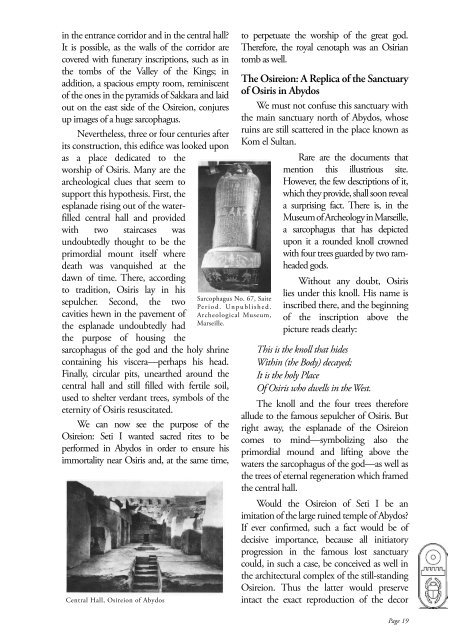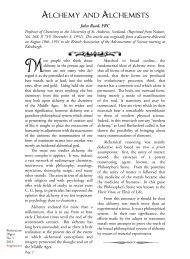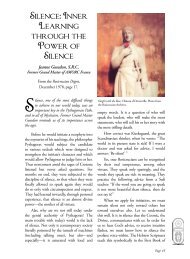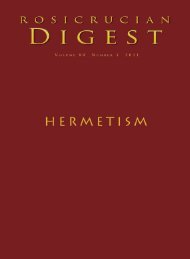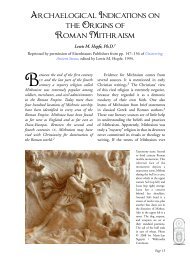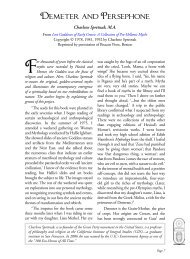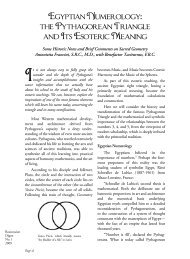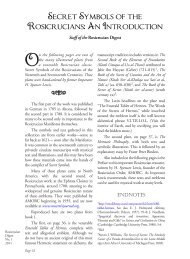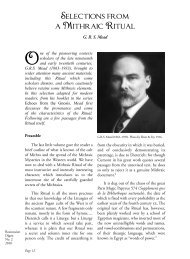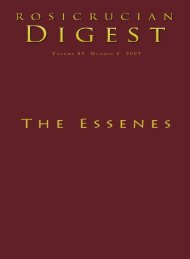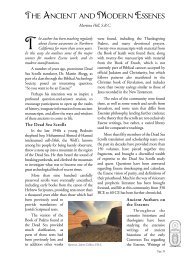Digest - Rosicrucian Order
Digest - Rosicrucian Order
Digest - Rosicrucian Order
Create successful ePaper yourself
Turn your PDF publications into a flip-book with our unique Google optimized e-Paper software.
in the entrance corridor and in the central hall?<br />
It is possible, as the walls of the corridor are<br />
covered with funerary inscriptions, such as in<br />
the tombs of the Valley of the Kings; in<br />
addition, a spacious empty room, reminiscent<br />
of the ones in the pyramids of Sakkara and laid<br />
out on the east side of the Osireion, conjures<br />
up images of a huge sarcophagus.<br />
Nevertheless, three or four centuries after<br />
its construction, this edifice was looked upon<br />
as a place dedicated to the<br />
worship of Osiris. Many are the<br />
archeological clues that seem to<br />
support this hypothesis. First, the<br />
esplanade rising out of the waterfilled<br />
central hall and provided<br />
with two staircases was<br />
undoubtedly thought to be the<br />
primordial mount itself where<br />
death was vanquished at the<br />
dawn of time. There, according<br />
to tradition, Osiris lay in his<br />
sepulcher. Second, the two<br />
cavities hewn in the pavement of<br />
the esplanade undoubtedly had<br />
the purpose of housing the<br />
sarcophagus of the god and the holy shrine<br />
containing his viscera—perhaps his head.<br />
Finally, circular pits, unearthed around the<br />
central hall and still filled with fertile soil,<br />
used to shelter verdant trees, symbols of the<br />
eternity of Osiris resuscitated.<br />
We can now see the purpose of the<br />
Osireion: Seti I wanted sacred rites to be<br />
performed in Abydos in order to ensure his<br />
immortality near Osiris and, at the same time,<br />
Central Hall, Osireion of Abydos<br />
Sarcophagus No. 67, Saite<br />
Pe r i o d . Un p u b l i s h e d .<br />
Archeological Museum,<br />
Marseille.<br />
to perpetuate the worship of the great god.<br />
Therefore, the royal cenotaph was an Osirian<br />
tomb as well.<br />
The Osireion: A Replica of the Sanctuary<br />
of Osiris in Abydos<br />
We must not confuse this sanctuary with<br />
the main sanctuary north of Abydos, whose<br />
ruins are still scattered in the place known as<br />
Kom el Sultan.<br />
Rare are the documents that<br />
mention this illustrious site.<br />
However, the few descriptions of it,<br />
which they provide, shall soon reveal<br />
a surprising fact. There is, in the<br />
Museum of Archeology in Marseille,<br />
a sarcophagus that has depicted<br />
upon it a rounded knoll crowned<br />
with four trees guarded by two ramheaded<br />
gods.<br />
Without any doubt, Osiris<br />
lies under this knoll. His name is<br />
inscribed there, and the beginning<br />
of the inscription above the<br />
picture reads clearly:<br />
This is the knoll that hides<br />
Within (the Body) decayed;<br />
It is the holy Place<br />
Of Osiris who dwells in the West.<br />
The knoll and the four trees therefore<br />
allude to the famous sepulcher of Osiris. But<br />
right away, the esplanade of the Osireion<br />
comes to mind—symbolizing also the<br />
primordial mound and lifting above the<br />
waters the sarcophagus of the god—as well as<br />
the trees of eternal regeneration which framed<br />
the central hall.<br />
Would the Osireion of Seti I be an<br />
imitation of the large ruined temple of Abydos?<br />
If ever confirmed, such a fact would be of<br />
decisive importance, because all initiatory<br />
progression in the famous lost sanctuary<br />
could, in such a case, be conceived as well in<br />
the architectural complex of the still-standing<br />
Osireion. Thus the latter would preserve<br />
intact the exact reproduction of the decor<br />
Page 19


